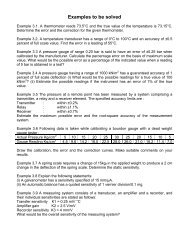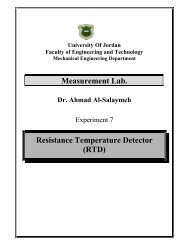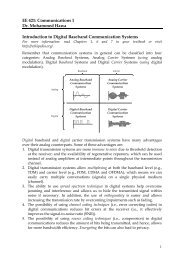Simulation of Third Generation CDMA Systems - Virginia Tech
Simulation of Third Generation CDMA Systems - Virginia Tech
Simulation of Third Generation CDMA Systems - Virginia Tech
Create successful ePaper yourself
Turn your PDF publications into a flip-book with our unique Google optimized e-Paper software.
• Primary and secondary Common Control Physical Channels (CCPCH) tocarry downlink common channels• Synchronization Channels (SCH) for cell search• Physical Random Access Channel (PRACH)The spreading and modulation for the DPDCH and the DPCCH for both the links aredescribed in the following two subsections.2.1.1 Uplink Spreading and ModulationIn the uplink the data modulation <strong>of</strong> both the DPDCH and the DPCCH is BinaryPhase Shift Keying (BPSK). The modulated DPCCH is mapped to the Q-channel, while thefirst DPDCH is mapped to the I-channel. Subsequently added DPDCHs are mappedalternatively to the I or the Q-channel. Spreading Modulation is applied after data modulationand before pulse shaping. The spreading modulation used in the uplink is dual channelQPSK. Spreading modulation consists <strong>of</strong> two different operations. The first one is spreadingwhere each data symbol is spread to a number <strong>of</strong> chips given by the spreading factor. Thisincreases the bandwidth <strong>of</strong> the signal. The second operation is scrambling where a complexvalued scrambling code is applied to spread signal. Figure 2.1 shows the spreading andmodulation for an uplink user. The uplink user has a DPDCH and a DPCCH.The bipolar data symbols on I and Q branches are independently multiplied bydifferent channelization codes. The channelization codes are known as Orthogonal VariableSpreading Factor (OVSF) codes. OVSF codes are discussed in section 2.4.10
















